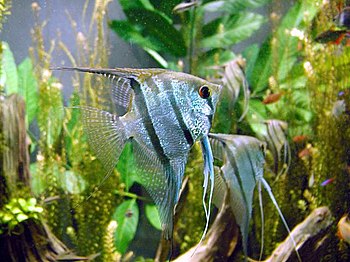 |
| Artificial Aquarium Plant |
When it comes to aquarium plants, there are two main choices: real or fake. Live would require care, just like houseplants. They will need to be chosen wish your fish species in mind and will require more of your time than fake plants, which require little effort and are easy to care for even if you're not an experienced fishkeeper. While fresh may die if the water quality is not monitored closely, fake plants can withstand everything. The only care required is an occasional cleaning in the sink.
Plastic plants are also available in a wide array of styles and colors, including neon shades, that simply isn't achievable if you choose to plant your aquarium with real aquatic plants. However, neon plants do not create a very natural setting and may stress out your fish. Many have found that plastic, even those with natural colors, simply do not have the realistic appearance they are after.
If you're looking for aquarium plants that are realistic, yet easy to care for, consider silk. These are just as easy to care for as plastic plants but lend a more natural appearance to the tank. Always purchase silk plants designed for aquariums, because they will not contain any chemicals that could leach into the water and harm your fish.
There are advantages to using real plants in an aquarium. If you are interested in breeding fish, you should know that some fish species will only breed in an environment with live plants. Fresh plants also add oxygen to the water and use nitrates, becoming a beneficial part of the nitrogen cycle and helping to clean your tank. Live plants are eaten by many species of fish, and in fact are one of the healthiest and most natural food sources you can provide for the herbivores in your tank.
Despite the benefits of using real plants, they can require specialized care. If you do choose to plant your aquarium with fresh plants, be sure that you understand their care requirements. Plants also require specialized aquatic fertilizers and lighting; no plant can grow without lights, which are required for photosynthesis. Many varieties of aquatic plants require specific pH levels or water temperatures. If these are incompatible with the needs of your fish, one or the other will suffer. You'll need to choose plant varieties that are compatible with the fish in your aquarium.
Cleaning a planted tank is more difficult than cleaning one with fake plants because real plants should not be uprooted for cleaning. As the plants naturally decay, there will be more waste material at the bottom of the tank, which can reduce water quality over time. While healthy plants will improve the aquarium habitat, those that are not cared for properly have the potential to harm your fish. Aquatic plants require pruning, just like your houseplants.
Only you decide whether planting your tank with real ones is worth the additional maintenance. If it is your first time ever having fish, choose fake ones. The complicated care of real ones can get quickly become overwhelming if you're not used to caring for an aquatic habitat.
|





